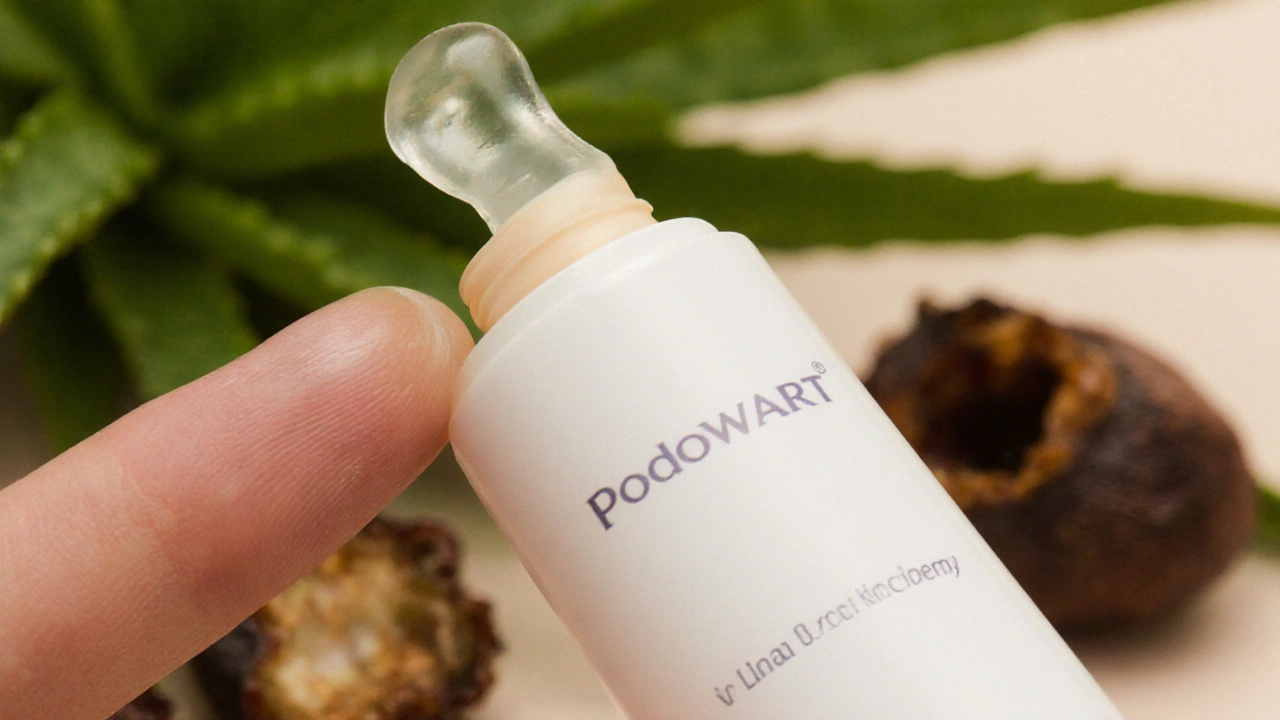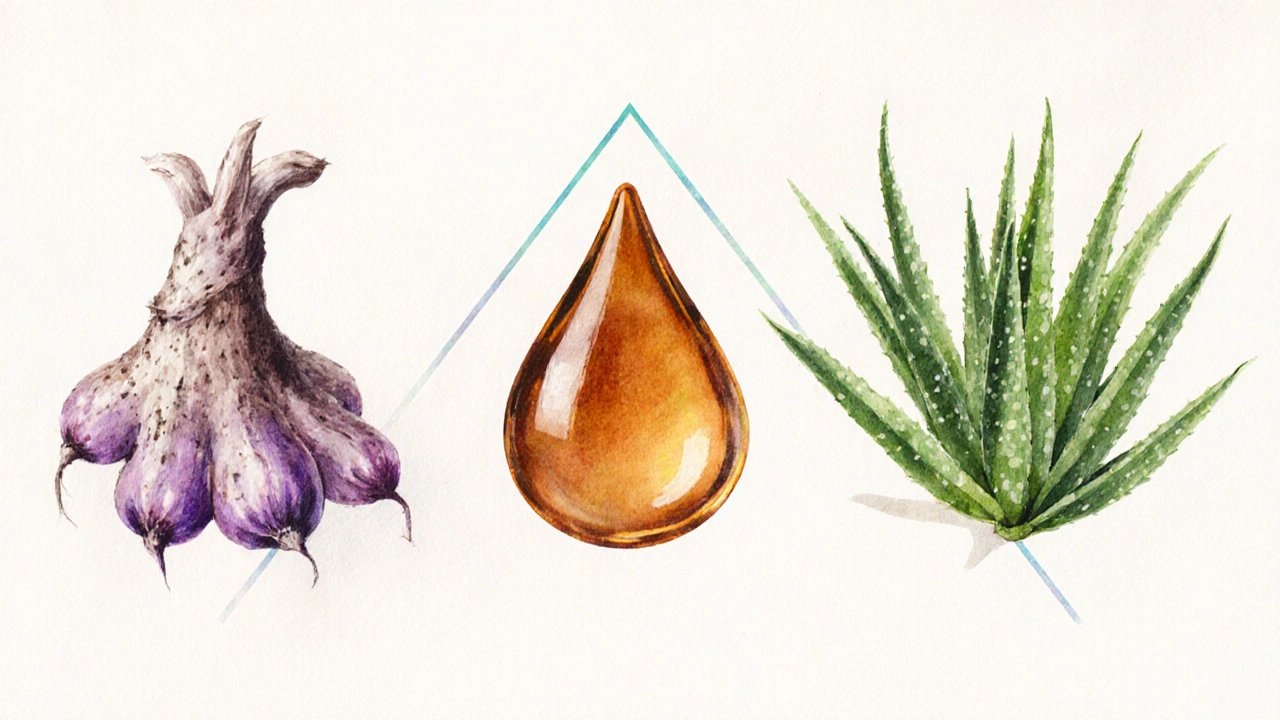
Podowart vs. Natural Remedies Comparison Tool
Podowart
Podophyllotoxin Benzoin Aloe Vera
Best for: HPV-related warts, minor burns, eczema flare-ups
Pros: Strong antiviral action, soothing Aloe Vera
Cons: Potential skin irritation, regulatory gray area
Tea Tree Oil
Terpinen-4-ol
Best for: Acne, fungal infections, insect bites
Pros: Broad antimicrobial, readily available
Cons: Can cause dermatitis if undiluted, weak antiviral
Witch Hazel
Tannic Acid
Best for: Inflammation, minor cuts, varicose vein relief
Pros: Gentle astringent, low allergy risk
Cons: Limited wart efficacy, mostly astringent
Calendula Extract
Flavonoids Triterpenoids
Best for: Skin redness, diaper rash, superficial wounds
Pros: Excellent soothing, safe for children
Cons: Slow healing, not antiviral
Neem Oil
Azadirachtin
Best for: Scalp psoriasis, viral skin lesions, insect repellent
Pros: Strong antiviral & anti-inflammatory, long-lasting
Cons: Strong odor, can be sticky, may clog pores
Recommendation
Select a condition to get personalized recommendations.
When you search for a natural remedy to calm skin irritation or tackle stubborn warts, you might stumble upon a product called Podowart. Marketed as a blend of three botanical extracts, it promises fast relief without harsh chemicals. But does it really stand up to other time‑tested options like tea tree oil or witch hazel? This guide breaks down the formula, compares it with popular alternatives, and helps you decide which one fits your skin‑care routine.
Key Takeaways
- Podowart combines Podophyllum resin, benzoin, and Aloe Vera for anti‑viral and soothing effects.
- Its wart‑fighting power mainly comes from podophyllotoxin, a natural mitotic inhibitor.
- Safety concerns include skin sensitivity and possible systemic absorption if over‑applied.
- Tea tree oil, witch hazel, and Calendula are common alternatives with distinct strengths and weaker anti‑viral activity.
- Choosing the right product depends on the condition you treat, skin type, and tolerance for possible side effects.
What is Podowart?
Podowart is a topical gel that blends Podophyllum resin, benzoin, and Aloe Vera. It is positioned as a natural alternative to prescription wart treatments and as a soothing balm for minor burns, insect bites, and eczema flare‑ups.
The formula is typically packaged in a 30ml tube, with a recommended application of a thin layer 2-3 times daily. Manufacturers claim that the synergy of the three ingredients delivers both antiviral activity and skin barrier support.
Ingredient Deep Dive
Podophyllum resin (also known as podophyllin) is extracted from the rhizomes of the American mandrake (Podophyllum peltatum). Its primary active compound, podophyllotoxin, interferes with microtubule formation, halting cell division-a mechanism that makes it effective against HPV‑induced warts.
Typical concentration in over‑the‑counter wart gels ranges from 0.1% to 0.5%. While potent, podophyllotoxin can cause local irritation, erythema, and, in rare cases, systemic toxicity if absorbed in large amounts.
Benzoin is a resin derived from the bark of Styrax trees. It acts as an astringent and antiseptic, helping to seal small cracks in the skin and reducing the risk of secondary infection.
In Podowart, benzoin also contributes a pleasant vanilla‑like scent, which masks the bitterness of podophyllin and improves user compliance.
Aloe Vera gel is widely recognized for its moisturizing and anti‑inflammatory properties. It contains polysaccharides that promote collagen synthesis and accelerate wound healing.
Combined with the harsher components, Aloe Vera softens the overall feel of the gel and mitigates burning sensations.

Safety Profile and Regulatory Status
In the United States, podophyllin is classified as a prescription‑only active ingredient for wart removal, though low‑dose formulations appear in some OTC products under strict labeling. The FDA requires warning labels about possible systemic effects, especially for pregnant women.
Benzoin and Aloe Vera are generally recognized as safe (GRAS) for topical use, but allergic reactions can occur in people sensitive to resinous substances.
Users should conduct a patch test: apply a pea‑sized amount on the inner forearm, wait 24hours, and look for redness or itching. If any reaction appears, discontinue use.
Because Podowart mixes a prescription‑grade resin with OTC excipients, the product sits in a regulatory gray zone in many countries. Always verify local guidelines before purchasing.
Popular Natural Alternatives
Several botanical remedies are commonly recommended for warts, minor burns, or skin irritation. Below is a quick snapshot of four options.
- Tea Tree Oil - a distilled oil from Melaleuca alternifolia leaves, rich in terpinen‑4‑ol, known for broad‑spectrum antimicrobial activity.
- Witch Hazel - a water‑based extract from Hamamelis virginiana, containing tannins that tighten skin and reduce inflammation.
- Calendula Extract - derived from marigold flowers, high in flavonoids and triterpenoids that promote tissue repair.
- Neem Oil - cold‑pressed oil from the seeds of Azadirachta indica, possessing antiviral and anti‑inflammatory compounds such as azadirachtin.
Each alternative targets a slightly different set of symptoms. Tea tree oil excels at killing bacteria and fungi, witch hazel shines as a mild astringent, Calendula calms redness, and neem oil offers a broader antiviral effect than most essential oils.
Side‑by‑Side Comparison
| Product / Ingredient | Key Active Compound | Primary Use Cases | Pros | Cons |
|---|---|---|---|---|
| Podowart | Podophyllotoxin (from Podophyllum resin) | HPV warts, minor burns, eczema flare‑ups | Strong anti‑viral action; soothing thanks to Aloe Vera | Potential skin irritation; regulatory gray area |
| Tea Tree Oil | Terpinen‑4‑ol | Acne, fungal infections, insect bites | Broad antimicrobial; readily available OTC | Can cause dermatitis if undiluted; weak anti‑viral |
| Witch Hazel | Tannic acid | Inflammation, minor cuts, varicose vein relief | Gentle astringent; low allergy risk | Limited wart efficacy; mostly astringent |
| Calendula Extract | Flavonoids & triterpenoids | Skin redness, diaper rash, superficial wounds | Excellent soothing; safe for children | Slow healing; not antiviral |
| Neem Oil | Azadirachtin | Scalp psoriasis, viral skin lesions, insect repellent | Strong antiviral & anti‑inflammatory; long‑lasting | Strong odor; can be sticky; may clog pores |
How to Choose the Right Remedy for You
Consider three factors: the condition you treat, your skin sensitivity, and how strict your local regulations are.
- Condition specificity. If you’re dealing with HPV‑related warts, Podowart’s podophyllotoxin gives it a clear advantage. For bacterial acne or fungal athlete’s foot, tea tree oil is more appropriate.
- Skin tolerance. Sensitive skins often react to resinous compounds. In such cases, witch hazel or Calendula provide a gentler experience.
- Regulatory comfort. If you prefer products with clear OTC status, stick to tea tree oil, witch hazel, or Neem oil, which are widely recognized as safe.
Mix‑and‑match strategies can also work. For example, applying a thin layer of Podowart twice daily for wart reduction, then switching to a Calendula ointment for post‑treatment soothing, balances efficacy with comfort.
Practical Tips for Applying Podowart and Alternatives
- Patch test first. As mentioned earlier, always test on a small skin area.
- Clean the area. Gently wash with mild soap, pat dry, and avoid using heavy moisturizers before application.
- Apply thinly. A pea‑size amount is enough; spreading too thick can increase irritation risk.
- Cover if needed. For warts, covering with a breathable bandage after application can enhance absorption, but remove it after 30minutes to prevent maceration.
- Store properly. Keep the tube in a cool, dark place. Heat can degrade podophyllotoxin and reduce potency.
- Monitor progress. Expect visible reduction in wart size within 2-3 weeks. If no change after 6 weeks, discontinue use and consult a dermatologist.
Frequently Asked Questions
Can I use Podowart on children?
Podowart contains podophyllotoxin, which is not recommended for children under 12years old because their skin absorbs chemicals more readily. Safer options for kids are Aloe‑based gels or Calendula ointments.
How does Podowart compare to prescription podophyllin cream?
Prescription podophyllin creams typically use a higher concentration (0.5‑1%) and are applied by a clinician. Podowart offers a lower dose (≈0.2%) for self‑care, making it less aggressive but also slower to work.
Is there a risk of scarring with Podowart?
When used as directed, scarring is rare. Over‑application or leaving the gel on for extended periods can cause deeper skin irritation, which may lead to hyperpigmentation or minor scarring.
Can I combine Podowart with other topical treatments?
Combining with other strong antiseptics (e.g., high‑strength benzoyl peroxide) can increase irritation. It's safest to alternate days: Podowart in the morning, a gentle moisturizer at night, and avoid overlapping harsh actives.
What should I do if I experience severe redness or swelling?
Stop using the product immediately, rinse the area with cool water, and apply a bland compress. If symptoms persist beyond 24hours, seek medical advice.




12 Comments
The presence of podophyllotoxin undeniably raises Podowart’s antiviral efficacy above that of conventional essential oils. Moreover, the Aloe Vera matrix mitigates the resin’s intrinsic irritancy, offering a balanced therapeutic window. Nonetheless, the regulatory ambiguity surrounding podophyllin necessitates vigilant consumer awareness.
i cant even bllll, that gel sounds like a love‑poison for my skin and i need it sooo bad!!!
While the comparative table presents an impressive breadth, the analysis skims over the pharmacokinetic nuances of podophyllotoxin. In a rigorously scientific discourse, one would expect a deeper exploration of systemic absorption risks. The omission renders the review somewhat perfunctory.
In the grand tapestry of dermal stewardship, each botanical agent occupies a distinct metaphysical niche; Podowart embodies the archetype of the diligent warrior, whereas tea tree oil assumes the role of the agile scout. Such analogies illuminate the underlying strategic considerations that guide therapeutic selection.
From a dermatological geopolitics perspective, domestic formulations like Podowart must champion indigenous phytochemicals-podophyllotoxin, benzoin, aloe-over imported synthetics; this aligns with bio‑sovereignty imperatives, market segmentation strategies, and compliance frameworks; consequently, the product leverages competitive differentiation, barrier‑to‑entry dynamics, and intellectual property capital.
It’s worth noting that for those with ultra‑sensitive skin, witch hazel or calendula often provide a gentler introductory experience, allowing the body to adapt before considering the more potent Podowart option.
The review glosses over the socioeconomic implications of marketing a semi‑prescription compound to the mass market; a more incisive critique would interrogate pricing structures, accessibility, and the ethicality of leveraging fear of warts to drive sales.
For anyone grappling with recurrent HPV warts, I recommend a disciplined patch‑test regimen: apply a pea‑sized dot on the inner forearm, observe for 24 hours, and, if tolerated, proceed with the prescribed twice‑daily schedule while documenting progress in a skin‑journal.
When navigating the labyrinth of natural dermatological remedies, the first compass point should be the specific pathology you aim to treat. HPV‑induced warts, for instance, demand an agent that can disrupt viral replication, a niche that podophyllotoxin uniquely fills. Conversely, bacterial acne thrives on sebum‑laden environments, making the broad‑spectrum antimicrobial action of tea tree oil more appropriate. Inflammatory conditions such as eczema or minor burns benefit from soothing polysaccharides, a role admirably served by Aloe Vera’s mucilaginous gel. The substrate of each product also matters; a resin‑rich base can potentiate irritation in sensitive epidermis, while a water‑based formulation tends to be more forgiving. Regulatory status cannot be ignored-while over‑the‑counter teas are universally accepted, podophyllotoxin‑containing gels hover in a gray zone that may expose users to legal ambiguity. Patch testing remains an indispensable safety net; a small application to the inner forearm can reveal latent hypersensitivity before full‑scale use. Dosage frequency likewise influences outcomes; excessive application of potent actives can precipitate erythema, whereas judicious, spaced dosing fosters gradual resolution. Patient adherence improves when the sensory experience aligns with personal preference-some find the scent of benzoin comforting, others are repelled by its intensity. Cost considerations also shape decisions; neem oil, for example, offers bulk affordability, whereas specialized Podowart tubes may command premium pricing. Accessibility of the product in local markets determines feasibility; not all regions stock podophyllotoxin‑based preparations, prompting reliance on locally sourced alternatives. Moreover, the psychosocial impact of visible skin lesions should inform therapeutic choice, as rapid‑acting solutions can alleviate stigma more effectively. Long‑term skin health hinges on avoiding cumulative irritation, which underscores the importance of rotating between actives to prevent tolerance. Ultimately, a personalized regimen-perhaps initiating with Podowart for wart reduction followed by calendula for post‑treatment soothing-embodies the principle of targeted, balanced care. By integrating these variables-pathology, ingredient potency, formulation base, regulatory context, safety protocols, sensory preferences, cost, availability, and psychosocial factors-clinicians and consumers alike can craft an evidence‑informed strategy that transcends the one‑size‑fits‑all paradigm.
I feel like I'm watching a soap opera when people debate warts versus tea tree-so much drama over a tiny bump.
Keep tracking your skin’s response daily; celebrating small improvements can fuel motivation and help you stay consistent with the chosen remedy.
Behold! The battlefield of skin care is set, and only those who wield the right botanical weapon shall emerge victorious-choose wisely, lest you fall to the tyranny of persistent lesions.